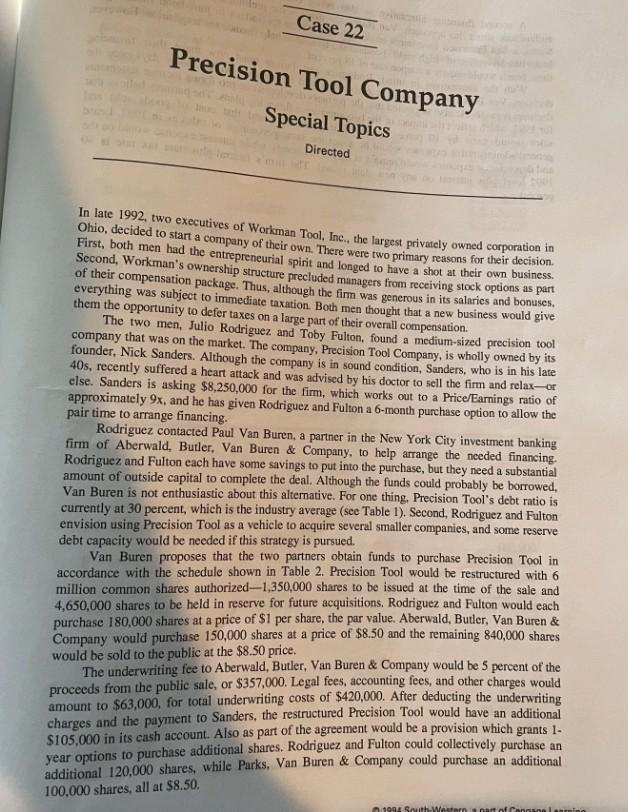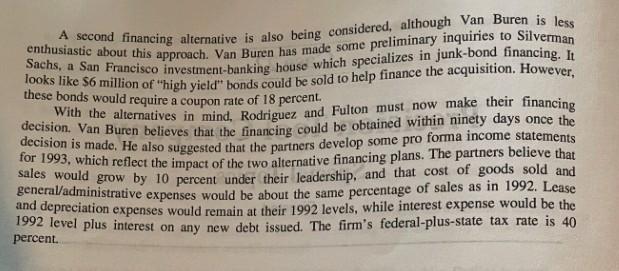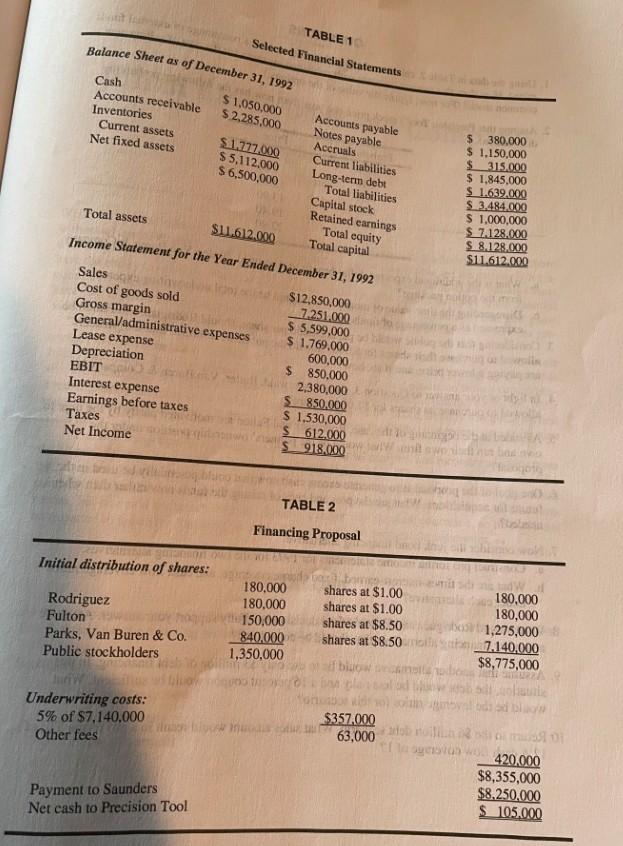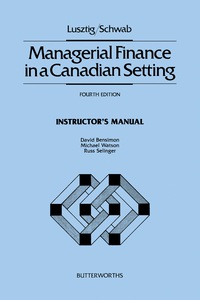Answered step by step
Verified Expert Solution
Question
1 Approved Answer
Please answer only 9 and 10 Question after reading case study. Case 22 Precision Tool Company Special Topics Directed In late 1992, two executives of
Please answer only 9 and 10 Question after reading case study.




Case 22 Precision Tool Company Special Topics Directed In late 1992, two executives of Workman Tool, Inc., the largest privately owned corporation in Ohio, decided to start a company of their own. There were two primary reasons for their decision First, both men had the entrepreneurial spirit and longed to have a shot at their own business. Second, Workman's ownership structure precluded managers from receiving stock options as part of their compensation package. Thus, although the firm was generous in its salaries and bonuses, everything was subject to immediate taxation. Both men thought that a new business would give them the opportunity to defer taxes on a large part of their overall compensation. The two men, Julio Rodriguez and Toby Fulton, found a medium-sized precision tool company that was on the market. The company, Precision Tool Company, is wholly owned by its founder, Nick Sanders. Although the company is in sound condition, Sanders, who is in his late 40s, recently suffered a heart attack and was advised by his doctor to sell the firm and relax-or else. Sanders is asking $8,250,000 for the firm, which works out to a Price/Earnings ratio of approximately 9x, and he has given Rodriguez and Fulton a 6-month purchase option to allow the pair time to arrange financing. Rodriguez contacted Paul Van Buren, a partner in the New York City investment banking firm of Aberwald, Butler, Van Buren & Company, to help arrange the needed financing Rodriguez and Fulton each have some savings to put into the purchase, but they need a substantial amount of outside capital to complete the deal. Although the funds could probably be borrowed, Van Buren is not enthusiastic about this alternative. For one thing. Precision Tool's debt ratio is currently at 30 percent, which is the industry average (see Table 1). Second, Rodriguez and Fulton envision using Precision Tool as a vehicle to acquire several smaller companies, and some reserve debt capacity would be needed if this strategy is pursued. Van Buren proposes that the two partners obtain funds to purchase Precision Tool in accordance with the schedule shown in Table 2. Precision Tool would be restructured with 6 million common shares authorized-1,350,000 shares to be issued at the time of the sale and 4,650,000 shares to be held in reserve for future acquisitions. Rodriguez and Fulton would cach purchase 180,000 shares at a price of $1 per share, the par value. Aberwald, Butler, Van Buren & Company would purchase 150,000 shares at a price of $8.50 and the remaining 840,000 shares The underwriting fee to Aberwald, Butler, Van Buren & Company would be 5 percent of the proceeds from the public sale, or $357,000. Legal fees, accounting fees, and other charges would would be sold to the public at the $8.50 price. amount to $63,000, for total underwriting costs of $420,000. After deducting the underwriting charges and the payment to Sanders, the restructured Precision Tool would have an additional $105,000 in its cash account. Also as part of the agreement would be a provision which grants 1. year options to purchase additional shares. Rodriguez and Fulton could collectively purchase an additional 120,000 shares, while Parks, Van Buren & Company could purchase an additional 100,000 shares, all at $8.50. 1994 South Westerna part of rannan rinn A second financing alternative is also being considered, although Van Buren is less Sachs, a San Francisco investment-banking house which specializes in junk-bond financing. It enthusiastic about this approach. Van Buren has made some preliminary inquiries to Silverman these bonds would require a coupon rate of 18 percent. decision. Van Buren believes that the financing could be obtained within ninety days once the With the alternatives in mind, Rodriguez and Fulton must now make their financing decision is made. He also suggested that the pareners develop some pro forma income statements for 1993, which reflect the impact of the two alternative financing plans. The partners believe that sales would grow by 10 percent under their leadership, and that cost of goods sold and general/administrative expenses would be about the same percentage of sales as in 1992. Lease and depreciation expenses would remain at their 1992 levels, while interest expense would be the 1992 level plus interest on any new debt issued. The firm's federal-plus-state tax rate is 40 percent. TABLE 1 Selected Financial Statements Balance Sheet as of December 31, 1992 Cash Accounts receivable Inventories Current assets Net fixed assets $1,050,000 $ 2.285.000 $1.777.000 $ 5,112,000 $6,500,000 Accounts payable Notes payable Accruals Current liabilities Long-ter det Total liabilities Capital stock Retained earnings Total equity Total capital $ 380.000 $ 1.150,000 $315.000 $ 1.845.000 $ 1.639.000 S.3.484.000 $ 1,000,000 $ 7.128.000 $8.128.000 $11.612.000 Total assets SU1.612.000 Income Statement for the Year Ended December 31, 1992 Sales Cost of goods sold Gross margin General/administrative expenses Lease expense Depreciation EBIT Interest expense Earnings before taxes Taxes Net Income $12.850,000 7.251.000 $ 5,599,000 $ 1.769,000 600,000 $ 850.000 2,380,000 S850,000 $ 1,530,000 $612.000 918.000 TABLE 2 Financing Proposal Initial distribution of shares: Rodriguez Fulton Parks, Van Buren & Co. Public stockholders 180,000 180,000 150,000 840,000 1,350,000 shares at $1.00 180.000 shares at $1.00 180,000 shares at $8.50 1,275,000 shares at $8.50 -7.140,000 $8,775,000 Underwriting costs: 5% of $7,140,000 Other fees $357.000 63,000 By mo 420.000 $8,355,000 $8.250,000 $ 105,000 Payment to Saunders Net cash to Precision Tool 9. Assume that another alternative would be to use only $3 million of debt financing. In this situation, the debt would be less risky and a 16 percent coupon would be sufficient. What would be the leverage ratios for this scenario? bul 10. Retum to the $6 million debt scenario. What sales amount would result in a pro forma Tle of 12 A cash flow coverage of 1? Case 22 Precision Tool Company Special Topics Directed In late 1992, two executives of Workman Tool, Inc., the largest privately owned corporation in Ohio, decided to start a company of their own. There were two primary reasons for their decision First, both men had the entrepreneurial spirit and longed to have a shot at their own business. Second, Workman's ownership structure precluded managers from receiving stock options as part of their compensation package. Thus, although the firm was generous in its salaries and bonuses, everything was subject to immediate taxation. Both men thought that a new business would give them the opportunity to defer taxes on a large part of their overall compensation. The two men, Julio Rodriguez and Toby Fulton, found a medium-sized precision tool company that was on the market. The company, Precision Tool Company, is wholly owned by its founder, Nick Sanders. Although the company is in sound condition, Sanders, who is in his late 40s, recently suffered a heart attack and was advised by his doctor to sell the firm and relax-or else. Sanders is asking $8,250,000 for the firm, which works out to a Price/Earnings ratio of approximately 9x, and he has given Rodriguez and Fulton a 6-month purchase option to allow the pair time to arrange financing. Rodriguez contacted Paul Van Buren, a partner in the New York City investment banking firm of Aberwald, Butler, Van Buren & Company, to help arrange the needed financing Rodriguez and Fulton each have some savings to put into the purchase, but they need a substantial amount of outside capital to complete the deal. Although the funds could probably be borrowed, Van Buren is not enthusiastic about this alternative. For one thing. Precision Tool's debt ratio is currently at 30 percent, which is the industry average (see Table 1). Second, Rodriguez and Fulton envision using Precision Tool as a vehicle to acquire several smaller companies, and some reserve debt capacity would be needed if this strategy is pursued. Van Buren proposes that the two partners obtain funds to purchase Precision Tool in accordance with the schedule shown in Table 2. Precision Tool would be restructured with 6 million common shares authorized-1,350,000 shares to be issued at the time of the sale and 4,650,000 shares to be held in reserve for future acquisitions. Rodriguez and Fulton would cach purchase 180,000 shares at a price of $1 per share, the par value. Aberwald, Butler, Van Buren & Company would purchase 150,000 shares at a price of $8.50 and the remaining 840,000 shares The underwriting fee to Aberwald, Butler, Van Buren & Company would be 5 percent of the proceeds from the public sale, or $357,000. Legal fees, accounting fees, and other charges would would be sold to the public at the $8.50 price. amount to $63,000, for total underwriting costs of $420,000. After deducting the underwriting charges and the payment to Sanders, the restructured Precision Tool would have an additional $105,000 in its cash account. Also as part of the agreement would be a provision which grants 1. year options to purchase additional shares. Rodriguez and Fulton could collectively purchase an additional 120,000 shares, while Parks, Van Buren & Company could purchase an additional 100,000 shares, all at $8.50. 1994 South Westerna part of rannan rinn A second financing alternative is also being considered, although Van Buren is less Sachs, a San Francisco investment-banking house which specializes in junk-bond financing. It enthusiastic about this approach. Van Buren has made some preliminary inquiries to Silverman these bonds would require a coupon rate of 18 percent. decision. Van Buren believes that the financing could be obtained within ninety days once the With the alternatives in mind, Rodriguez and Fulton must now make their financing decision is made. He also suggested that the pareners develop some pro forma income statements for 1993, which reflect the impact of the two alternative financing plans. The partners believe that sales would grow by 10 percent under their leadership, and that cost of goods sold and general/administrative expenses would be about the same percentage of sales as in 1992. Lease and depreciation expenses would remain at their 1992 levels, while interest expense would be the 1992 level plus interest on any new debt issued. The firm's federal-plus-state tax rate is 40 percent. TABLE 1 Selected Financial Statements Balance Sheet as of December 31, 1992 Cash Accounts receivable Inventories Current assets Net fixed assets $1,050,000 $ 2.285.000 $1.777.000 $ 5,112,000 $6,500,000 Accounts payable Notes payable Accruals Current liabilities Long-ter det Total liabilities Capital stock Retained earnings Total equity Total capital $ 380.000 $ 1.150,000 $315.000 $ 1.845.000 $ 1.639.000 S.3.484.000 $ 1,000,000 $ 7.128.000 $8.128.000 $11.612.000 Total assets SU1.612.000 Income Statement for the Year Ended December 31, 1992 Sales Cost of goods sold Gross margin General/administrative expenses Lease expense Depreciation EBIT Interest expense Earnings before taxes Taxes Net Income $12.850,000 7.251.000 $ 5,599,000 $ 1.769,000 600,000 $ 850.000 2,380,000 S850,000 $ 1,530,000 $612.000 918.000 TABLE 2 Financing Proposal Initial distribution of shares: Rodriguez Fulton Parks, Van Buren & Co. Public stockholders 180,000 180,000 150,000 840,000 1,350,000 shares at $1.00 180.000 shares at $1.00 180,000 shares at $8.50 1,275,000 shares at $8.50 -7.140,000 $8,775,000 Underwriting costs: 5% of $7,140,000 Other fees $357.000 63,000 By mo 420.000 $8,355,000 $8.250,000 $ 105,000 Payment to Saunders Net cash to Precision Tool 9. Assume that another alternative would be to use only $3 million of debt financing. In this situation, the debt would be less risky and a 16 percent coupon would be sufficient. What would be the leverage ratios for this scenario? bul 10. Retum to the $6 million debt scenario. What sales amount would result in a pro forma Tle of 12 A cash flow coverage of 1
Step by Step Solution
There are 3 Steps involved in it
Step: 1

Get Instant Access to Expert-Tailored Solutions
See step-by-step solutions with expert insights and AI powered tools for academic success
Step: 2

Step: 3

Ace Your Homework with AI
Get the answers you need in no time with our AI-driven, step-by-step assistance
Get Started


